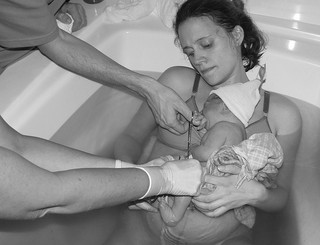New Cochrane Review: Delayed Cord Clamping Likely Beneficial for Healthy Term Newborns
By: Sharon Muza, BS, LCCE, FACCE, CD/BDT(DONA), CLE | 0 Comments
Last fall, Dr. Mark Sloan wrote an extremely well-received post on Science & Sensibility, Common Objections to Delayed Cord Clamping; What's the Evidence Say? that both professionals and consumers could use to understand and discuss the benefits of delayed cord clamping. From that post, we read that early cord clamping is an intervention that needs to change. Yet, early cord clamping is still observed in L&D rooms across the United States, despite the mounting evidence for waiting at least 1-3 minutes before clamping occurs. A new Cochrane review was just released in July, 2013, and I am grateful to Dr. Sloan for summarizing this review and sharing the new information on this topic. - Sharon Muza, Community Manager, Science & Sensibility

flickr.com/photos/lovemybunnies/4740682244/
A new Cochrane review of the timing of cord clamping in healthy term neonates was released earlier this month: Effect of timing of umbilical cord clamping of term infants on mother and baby outcomes. It's an update of a 2009 review on the subject, and the language is more pro-delayed cord clamping (ie, clamping the cord at 1-3 minutes after birth) this time around. Here's an excerpt from the Author's Conclusions:
"A more liberal approach to delaying clamping of the umbilical cord in healthy term infants appears to be warranted, particularly in light of growing evidence that delayed cord clamping increases early haemoglobin concentrations and iron stores in infants. Delayed cord clamping is likely to be beneficial as long as access to treatment for jaundice requiring phototherapy is available."
To understand why this change in emphasis since the 2009 Cochrane review is important, let's first look at why the timing of cord clamping is important to newborns, how current obstetric practice came to be, and what the Cochrane review did (and didn't) find.
A brief physiology review
At term, roughly 1/3 of a fetus's blood supply resides in the placenta. In the course of labor and delivery, much of that blood is transfused from the placenta into the fetus/newborn, driven by the force of uterine contractions. That transfusion continues beyond the moment of birth; if left undisturbed for 1 to 3 minutes, the placenta will deliver about three additional ounces of blood to the newborn.
That may not sound like much, but three ounces of blood is equivalent to a three month supply of iron for the newborn. Iron is critical to brain growth and development; iron deficiency is a known cause of cognitive and social-emotional deficits in infants, which may be permanent. As breast milk alone may not supply a baby with all the iron he or she needs, it's that additional iron that makes delayed cord clamping (DCC) so important.
A brief history of cord clamping
Until the relatively recent past, the umbilical cord was generally allowed to stop pulsating before it was cut and tied off. Aristotle and Hippocrates, among many other medical and science writers, wrote approvingly of the practice. The first mention of early cord clamping (ECC) - cutting the cord before pulsation has ceased - is found in the 1600s, when management of the third stage of labor changed with the rise of male midwives, flat-on-the-back birthing practices, and forceps.
Though ECC gained in popularity, controversy dogged the practice from the beginning. To give just one example, the prominent British physician Erasmus Darwin (Charles's grandfather) condemned the practice, declaring in 1801 that early cord clamping was "a very injurious thing" that left babies "much weaker than [they] ought to be."
Despite ongoing objections, ECC became the obstetrical standard of care in the mid-1960s, promoted primarily as a tool to prevent maternal postpartum hemorrhage (PPH). Though subsequent research has shown that ECC is of no benefit in postpartum hemorrhage (PPH) prevention, the practice remains a firmly entrenched part of obstetrical care in the U.S.
What did the 2013 Cochrane review find?
The review found that DCC babies had significantly higher body iron stores than ECC babies, an increase that persisted for months.
What didn't the Cochrane review find?
Maternal adverse outcomes: The review found no significant ECC-versus-DCC differences in any maternal outcomes, including postpartum hemorrhage, length of the third stage of labor, need for blood transfusion, and need for manual removal of the placenta.
Neonatal adverse outcomes: Similarly, with the single exception of a slight increase in the need for phototherapy to treat hyperbilirubinemia (discussed below), there were no significant differences between ECC and DCC babies in neonatal outcomes such as mortality, Apgar scores < 7 at five minutes, need for resuscitation, NICU admission, respiratory distress, polycythemia, and clinical jaundice.
The apparent association between DCC and an increased need for phototherapy is a bit controversial. As pointed out by Dr. Judith Mercer, an expert on the benefits of delayed clamping, this concern is based largely on a single unpublished 1996 study performed by one of the Cochrane review's authors (McDonald). McDonald's study is one of only two of the nearly forty studies considered for inclusion in the current review that includes unpublished data; when that data is removed, the difference between groups loses significance.
Of note, the two studies added since the 2009 review found no association between delayed clamping and hyperbilirubinemia requiring phototherapy (Al-Tawil 2012, Andersson 2011). It should also be pointed out that none of the babies in these studies was harmed by hyperbilirubinemia. All recovered completely; there were no cases of kernicterus - brain damage caused by severe neonatal jaundice.
Whatever the case regarding delayed clamping and phototherapy, there's no doubt that iron deficiency in infancy can lead to permanent cognitive and social-emotional deficits. The global benefits of increased iron stores during a critical period of brain development would seem to outweigh that concern.
The bottom line
For healthy term babies, a delay of 1-3 minutes before cord clamping has been shown to increase neonatal iron stores at a critical period of brain development, with virtually no risk of harm to mother and baby. Conversely, there is no convincing argument in support of clamping the umbilical cord before a minute of age.
Given that ECC has been shown to have no impact on maternal PPH, and that it offers no demonstrable benefit to healthy term newborns (and may in fact be harmful, by reducing body iron stores during a critical period of brain development), the question isn't "Why switch to delayed cord clamping?" It's this: "Why continue to intervene?"
Will obstetric practice change? Not immediately, if the recent Huffington Post comments of Dr. Jeffrey Ecker, ACOG chair of obstetric practice, are any indication:
"Over time, I believe we'll see an evolution in practice with appropriate women and babies - babies that don't otherwise need immediate attention," Ecker said. "I don't think it is all going to change in a year. But in five, 10 years, we'll look back and say, ' Boy, this is different.'"
The best way to speed up that process is for pregnant women and providers of maternity care services to press their local hospitals for change now.
References
Al-Tawil, M. M., Abdel-Aal, M. R., & Kaddah, M. A. (2012). A randomized controlled trial on delayed cord clamping and iron status at 3 - 5 months in term neonates held at the level of maternal pelvis. Journal of Neonatal-Perinatal Medicine, 5(4), 319-326.
Andersson, O., Hellström-Westas, L., Andersson, D., & Domellöf, M. (2011). Effect of delayed versus early umbilical cord clamping on neonatal outcomes and iron status at 4 months: a randomised controlled trial. BMJ: British Medical Journal, 343.
California WIC Association and the UC Davis Human Lactation Center. (2012) Maternity Care Matters; Overcoming Barriers to Breastfeeding. A Policy Update on California Breastfeeding and Hospital Performance. Retrieved from http://calwic.org/storage/restricted/hospitalreport/Maternity%20Care%20Matters_2012.pdf
McDonald, S. J., Middleton, P., Dowswell, T., & Morris, P. S. (2013). Effect of timing of umbilical cord clamping of term infants on mother and baby outcomes. Health.
Pearson, Catherine. "Cord Clamping: How Delaying Helps Babies." The Huffington Post. TheHuffingtonPost.com, 11 July 2013. Web. 24 July 2013.
About Mark Sloan, MD
 Mark Sloan has been a pediatrician and a Fellow of the American Academy of Pediatrics for more than 25 years. Since 1982, he has practiced with the Permanente Medical Group in Sacramento and Santa Rosa, California, where he was Chief of Pediatrics from 1997 to 2002. He is an Assistant Clinical Professor in the Department of Community and Family Medicine at the University of California, San Francisco. Dr. Sloan's first book, Birth Day: A Pediatrician Explores the Science, the History and the Wonder of Childbirth was published in 2009 by Ballantine Books. His writing has appeared in the Chicago Tribune, the San Francisco Chronicle, the San Francisco Examiner, and Notre Dame Magazine, among other publications. Dr. Sloan can be reached through his blog.
Mark Sloan has been a pediatrician and a Fellow of the American Academy of Pediatrics for more than 25 years. Since 1982, he has practiced with the Permanente Medical Group in Sacramento and Santa Rosa, California, where he was Chief of Pediatrics from 1997 to 2002. He is an Assistant Clinical Professor in the Department of Community and Family Medicine at the University of California, San Francisco. Dr. Sloan's first book, Birth Day: A Pediatrician Explores the Science, the History and the Wonder of Childbirth was published in 2009 by Ballantine Books. His writing has appeared in the Chicago Tribune, the San Francisco Chronicle, the San Francisco Examiner, and Notre Dame Magazine, among other publications. Dr. Sloan can be reached through his blog.
Published: July 24, 2013
Tags
Delayed Cord ClampingPlacentaNewbornsMaternal Infant CareBabiesUmbilical Cord ClampingEvidence Based MedicineMark SloanEarly Cord ClampingJaundice